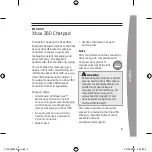
5.1 Motor Performance Fine-Tuning
This section offers helpful information for counteracting oscillation, hunting, and other problems that occur while performing
a trial run. Refer to the appropriate control method in this section.
Note:
This section describes commonly edited parameters that may be set incorrectly. Consult Yaskawa for more information on detailed settings
and for fine-tuning the drive.
u
Fine-Tuning V/f Control
Table 5.1 Parameters for Fine-Tuning Performance in V/f Control
Problem
Parameter No.
Corrective Action
Default
Suggested
Setting
Motor hunting and
oscillation at speeds
between 10 and 40 Hz
Hunting Prevention
Gain (n1-02)
• Reduce the setting if insufficient motor torque relative to the
size of the load causes hunting.
• Increase the setting when motor hunting and oscillation occur
with a light load.
• Reduce the setting if hunting occurs when using a motor with
a relatively low inductance, such as a high-frequency motor or
a motor with a larger frame size.
1.00
0.10 to 2.00
• Motor noise
• Motor hunting and
oscillation at speeds
up to 40 Hz
Carrier Frequency
Selection (C6-02)
• Increase the carrier frequency If the motor noise is too loud.
• Lower the carrier frequency when motor hunting and
oscillation occur at speeds up to 40 Hz.
• The default setting for the carrier frequency depends on the
drive capacity (o2-04).
1 (2 kHz)
1 to maximum
setting
• Poor torque or speed
response
• Motor hunting and
oscillation
Torque Compensation
Primary Delay Time
(C4-02)
• Reduce the setting if motor torque and speed response are too
slow.
• Increase the setting if motor hunting and oscillation occur.
200 ms
100 to 1000 ms
• Poor motor torque at
speeds below 10 Hz
• Motor hunting and
oscillation
Torque Compensation
Gain (C4-01)
• Increase the setting if motor torque is insufficient at speeds
below 10 Hz.
• Reduce the setting if motor hunting and oscillation with a
relatively light load.
1.00
0.50 to 1.50
• Poor motor torque at
low speeds
• Motor instability at
motor start
Mid Output Voltage A
(E1-08)
Minimum Output
Voltage (E1-10)
• Increase the setting if motor torque is insufficient at speeds
below 10 Hz.
• Reduce the setting If motor instability occurs at motor start.
Depends on
o2-04, Drive
Model
Selection
Default setting
±5 V
Poor speed precision
(V/f control)
Slip Compensation Gain
(C3-01)
Set the motor-rated current (E2-01), motor-rated slip (E2-02),
and motor no-load current (E2-03), then adjust the slip
compensation gain (C3-01).
0.0
(no slip
compen-
sation)
0.5 to 1.5
u
Fine-Tuning Open Loop Vector Control
Table 5.2 Parameters for Fine-Tuning Performance in OLV
Problem
Parameter No.
Corrective Action
Default
Suggested
Setting
• Poor motor torque
and speed response
• Motor hunting and
oscillation at speeds
between 10 and 40 Hz
AFR Gain
(n2-01)
• Gradually reduce the setting in 0.05 increments if motor torque
and speed response are too slow.
• Gradually increase the setting in 0.05 increments if motor hunting
and oscillation occur.
1.00
0.50 to 2.00
• Poor motor torque
and speed response
• Motor hunting and
oscillation at speeds
between 10 and 40 Hz
AFR Time Constant 1
(n2-02)
• Gradually reduce the setting in 10 ms increments and check the
performance to improve motor torque speed response.
• Gradually increase the setting by 50 ms increments and check the
performance if motor hunting and oscillation occur as a result of
load inertia.
50 ms
50 to 2000 ms
• Poor motor torque
and speed response
• Motor hunting and
oscillation
Torque Compensation
Primary Delay Time
Constant 1 (C4-02)
• Gradually reduce the setting in 2 ms increments and check the
performance to improve motor torque speed response.
• Gradually increase the setting in 10 ms increments if motor
hunting and oscillation occur.
20 ms
20 to 100 ms
5.1 Motor Performance Fine-Tuning
178
YASKAWA TOEPYAIUPW01A YASKAWA AC Drive - U1000 iQpump Matrix Drive User Manual
















































